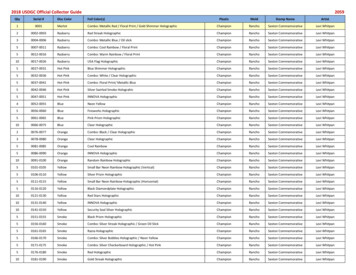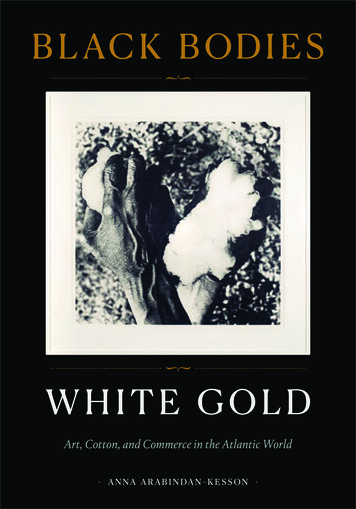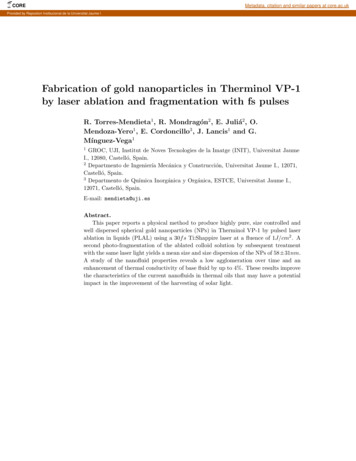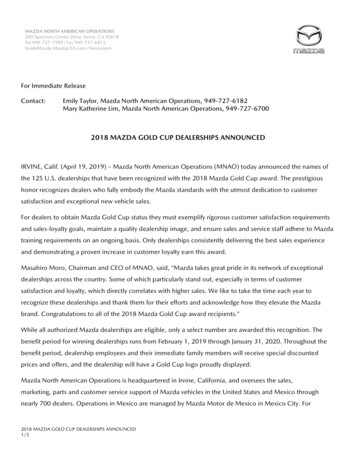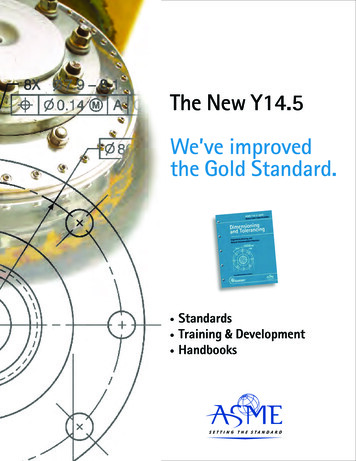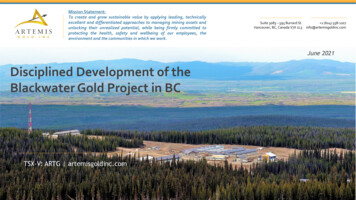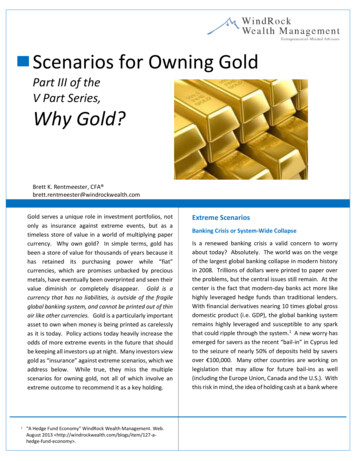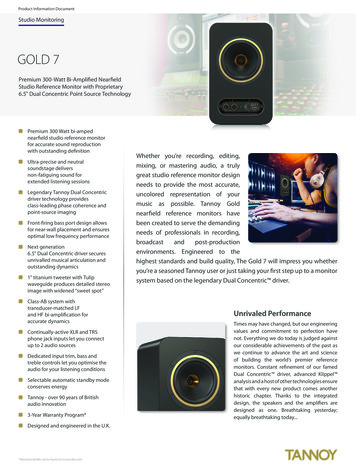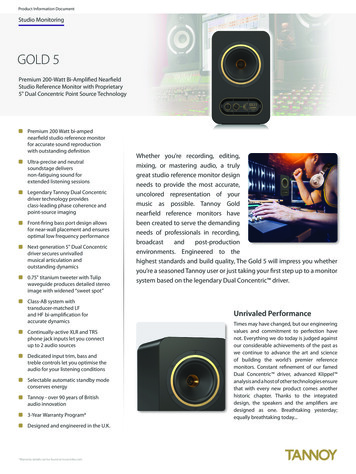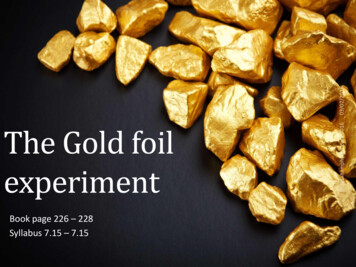
Transcription
03/02/2016Book page 226 – 228Syllabus 7.15 – 7.15 cgrahamphysics.com 2016The Gold foilexperiment
Learning Outcomes1. Investigate the history of the discovery ofthe atom as we know it todayFirst task is to create a timeline of the discoveryof the atom using the timeline application .Watchthe video clip to learn how to use Timeline. Whenyou are done export your timeline as jpeg photoand print it.The Model of the atomResults & Processing EvidenceTask 2: How do we know what isinside the atom?Why do we use models?Write an explanation on yourposter.Task 3: Using nearpod watch the twopresentation about the model of theatom. Explain Dalton’s model,J.J.Thomsons model and Rutherford’smodel of the atom. Include photos ordiagrams for each model. Include thenames, masses and charge of the particlesinside an atom as we know it todayhttps://www.nearpod.com/Homework:Finish the Past paperexam questionsThis will be handedin and markedtogether with yourposterThe factors that affect the deflection of alpha particlesTask 5: Research how charge and speed affects the deflectionof alpha particles by a nucleus. Why were alpha particles usedand not electrons?Include your findings with a diagramon your poster.03/02/2016TASKSYou need to researchthe development of theatom as we know ittoday. You can use theapplication popplet tocreate a mindmapThe final task is tocreate a poster,displaying thedifferent individualtasksThe Gold foil experimentTask 4: Explain the gold foilexperiment and the outcome.What is another name for thisexperiment? Why? What does theobservation tells us about thestructure of the nucleus? Thereare three distinct outcomes. Nameeach and explain what can beconcluded from the observation.Include a diagram of theexperimental setup and of theoutcomeAnswer WS 1 cgrahamphysics.com 2016The Gold foil experiment & history
cgrahamphysics.com 2016 Draw a time line about the discovery of the atom starting withthe Greek Philosophers until Rutherford’s model of the atom Easily Create Timelines Using the Timeline App.mp4 Watch the two applets BrainPop Atomic Model.swf Rutherford's experiment.swf The following link has some good information and a link to theapplets: rt 1503/02/2016Starter
The big pictureHave you ever wondered? cgrahamphysics.com 201603/02/2016How do we know the structure of an atom?
How do we know? cgrahamphysics.com 201603/02/20161910RutherfordGeigerMarsden
The Plum Puddingmodel:An atom is a vesphere with lots of–ve particlespositioned throughout cgrahamphysics.com 2016They knew that there must be ve and –ve charges in an atomfrom electrostatic effects!03/02/2016What did scientists used to think an atom lookedlike?
cgrahamphysics.com 201603/02/2016Geiger and Marsden tried to test this by firing αparticles at gold, to see how they bounce off:Rutherford.MOVrutherford-scattering en.jar
1910Geiger-Marsden ResultRutherford later said,"It was almost as incredible as if you fired afifteen-inch shell at a piece of tissue paper and itcame back and hit you." cgrahamphysics.com 201603/02/2016Expected “PlumPudding” Model Result
Models of the atomWe now know that all matter is made of atoms, but ideasabout atomic structure have changed over time.The idea of atoms was first suggested in 450 BC by theGreek philosopher Democritus.In 1803, John Daltonreintroduced the idea thateverything is made of atoms.He said atoms were solid spheresof matter that could not be split.Dalton also suggested that eachelement contained identical atoms.For example, gold is an elementmade up of only gold atoms.9 of 23 Boardworks Ltd 2011
JJ ThomsonIn 1897, whilst studying cathode rays, JJ Thomsondiscovered tiny particles with a negative charge.These negative particles weregiven out by atoms and weremuch smaller than atoms.Thomson had discoveredthe existence of electrons.This discovery contradictedDalton’s theory that atomswere solid spheres of matter.This led Thomson to propose a new model of the atom.10 of 23 Boardworks Ltd 2011
The resultsThe results of Geiger and Marsden’s experiment were:2. Some alpha particleswere slightly deflectedby the gold foil.3. A few alphaparticles werebounced backfrom the gold foil.1. Most alpha particleswent straight throughthe gold foil, withoutany deflection.The experiment was carried out in a vacuum, so deflectionof the alpha particles must have been due to the gold foil.How can these results be explained in terms of atoms?11 of 23 Boardworks Ltd 2011
Rutherford’s interpretationRutherford had expected all the alpha radiation to passthrough the gold foil. He was surprised that some alphaparticles were deflected slightly or bounced back.The plum pudding model could not explain these results,so Rutherford proposed his nuclear model of the atom.He suggested that an atom ismostly empty space with itspositive charge and most of itsmass in a tiny central nucleus.Electrons orbited thisnucleus at a distance, likeplanets around the Sun.12 of 23 Boardworks Ltd 2011
The modern modelExperiments showed that Rutherford’s atomic model (a tiny,positively-charged nucleus orbited by electrons) was correct.Further developments in understanding about atomicstructure followed, but Rutherford’s nuclear model stillforms the basis of the modern model of the atom.The nucleus is wheremost of the mass of theatom is found. It containsprotons and neutrons.The electrons orbit thenucleus in shells.13 of 23 Boardworks Ltd 2011
What are atoms made of?Atoms are made up of three smaller particles:protonsneutronselectronsThe protons and neutrons exist in adense core at the centre of the atom.This is called the nucleus.The electrons are spread outaround the edge of the atom.They orbit the nucleus inlayers called shells.14 of 23 Boardworks Ltd 2011
Mass and electrical chargeThere are two properties of protons, neutrons and electronsthat are especially important: mass electrical charge.particlemasschargeproton1 1neutron10electronalmost 0-1The atoms of an element contain equal numbers ofprotons and electrons and so have no overall charge.15 of 23 Boardworks Ltd 2011
Alpha particles areattracted to a negativelycharged plate. This confirms that theymust be positively chargedas unlike charges attract. Alpha particles are heliumnuclei; they contain 2protons which gives themtheir positive charge.Magnetic field When a charged particle cutsthrough a magnetic field itexperiences a force referredto as the motor effect. Alpha particles are deflectedby a magnetic field confirmingthat they must carry a charge. The direction of deflectionwhich can be determined byFleming’s left hand ruledemonstrates that they mustbe positively charged. cgrahamphysics.com 2016Electric field03/02/2016Factors affecting deflection
cgrahamphysics.com 2016 The alpha, traveling at 10% the speed of light, penetrates theatom and gets very close to the nucleus. However, the repulsion between the alpha and the atomnucleus is so great that the atom flings the alpha back out,and it does so in a hyperbolic path. Depending on various factors, this occasionally results in thealpha being turned around 90 or more. The very heavy nucleus recoils a bit from the impact, butessentially goes nowhere. The faster they hit the nucleus the faster they were repelled03/02/2016Speed and deflection
The Gold foil experiment & history Learning Outcomes 1. Investigate the history of the discovery o

